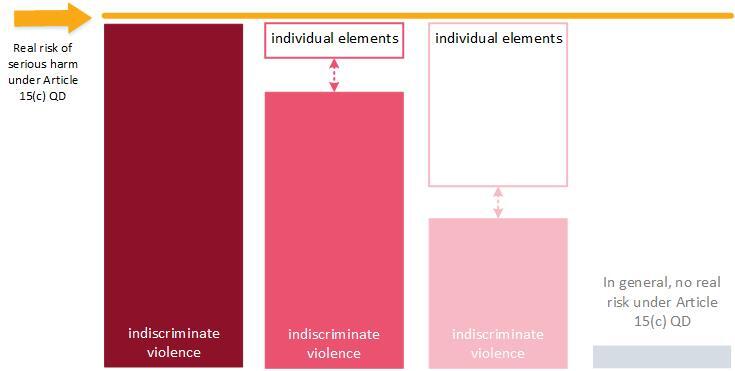COMMON ANALYSIS
Last update: February 2023
The common analysis regarding the degree of indiscriminate violence combines quantitative and qualitative elements in a holistic and inclusive assessment. The security situation in the respective territories is assessed by taking into account the following elements (Figure 5).
Figure 5. Indicators in the assessment of the level of indiscriminate violence.
For more information on the methodology and indicators used to assess the level of indiscriminate violence in country guidance documents, see ‘Country Guidance: explained’.
The next sections provide detailed information and assessment of the level of indiscriminate violence and the risk it represents for civilians in Syria per governorate. Summaries are structured according to the following elements:
- General information
- Background of the conflict
- Actors: control and presence
- Nature of violence and examples of incidents
- Incidents: data
Data concerning this indicator are based on ACLED reporting on the period from 1st April 2021 – 31st July 2022) along with additional information included in the COI Update for the period August – October 2022. The COI summaries focus in particular on the number of incidents coded as battles, explosions/remote violence and violence against civilians. They are further calculated as an average per week.
- Geographical scope
- Civilian fatalities: data
This indicator is based on data collected by the Syrian Network of Human Rights (SNHR). SNHR records only civilian fatalities. Data on injured civilians, which would also be relevant to take into account, are not systematically available. The available data are desegrated for two reporting periods, April – December 2021, and January – October 2022. The latter data are further presented as an approximate number of civilian fatalities per 100 000 inhabitants in the governorate. The estimation uses UNOCHA data on population.
- Displacement
This indicator is based on UNOCHA data focusing on IDP movements for the period from 1st January 2021 until 30th April or 31st May 2022, depending on the governorate. These IDP figures do not refer solely to conflict-induced displacement and can include also IDP movements for other reasons (e.g. poverty). Furthermore, UNOCHA data on spontaneous returns for the same time period are also provided.
- Further impact on civilians
The COI used as a basis for this assessment cannot be considered a complete representation of the extent of indiscriminate violence and its impact on the life of civilians. Concerns with regard to underreporting should be underlined.
Based on the indicators above, the situation in each governorate is assessed along the following categories of levels of indiscriminate violence (Figure 6).
Figure 6. Indiscriminate violence and individual elements in establishing real risk of serious harm under Article 15(c) QD.

Depending on the level of indiscriminate violence taking place, the territories in a country are usually categorised as follows.
|
Areas where the degree of indiscriminate violence reaches such an exceptionally high level that substantial grounds are shown for believing that a civilian, returned to the relevant area, would, solely on account of their presence there, face a real risk of being subject to the serious threat referred to in Article 15(c) QD. Accordingly, additional individual elements are not required in order to substantiate subsidiary protection needs under Article 15(c) QD. |
|
|
Areas where ’mere presence’ in the area would not be sufficient to establish a real risk of serious harm under Article 15(c) QD, however, indiscriminate violence reaches a high level. Accordingly, a lower level of individual elements is required to show substantial grounds for believing that a civilian, returned to the area, would face a real risk of serious harm in the meaning of Article 15(c) QD. |
|
|
Areas where indiscriminate violence is taking place, however not at a high level. Accordingly, a higher level of individual elements is required in order to show substantial grounds for believing that a civilian, returned to the area, would face a real risk of serious harm in the meaning of Article 15(c) QD. |
|
|
Areas where, in general, there is no real risk for a civilian to be personally affected within the meaning of Article 15(c) QD. This may be because the criteria for an armed conflict within the meaning of this provision are not met, because no indiscriminate violence is taking place, or because the level of indiscriminate violence is so low, that in general there would be no real risk for a civilian to be affected by it. |
